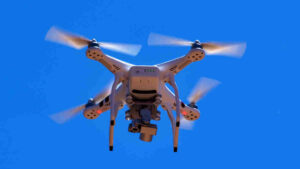From UAVs to Walmart: Why Elsight has a first-mover advantage in the global market for drone transport technology

A test flight is flown by a DroneUp pilot in preparation for drone delivery of COVID-19 home self-collection kits from Walmart. Pic: Getty
The company’s Halo platform was recently included in the first live drone delivery hub set up by the US retail giant.
After years of development, communications technology company Elsight (ASX:ELS) is now positioned at the forefront of major changes in global connectivity which have been accelerated by the COVID-19 pandemic.
And heading into 2022, the company’s product suite – led by its market-leading Halo data transmission device – is set to provide it with material commercial opportunities across multiple fields.
That outlook is a by-product of Elsight’s research partnership with a number of leading companies in fields spanning drone transport, unmanned aerial vehicles (UAVs) and robotics.
As the company undergoes a busy period of development, Stockhead caught up with Elsight CEO Yoav Amitai to discuss its near-term strategy.
Global market shift
Commenting on the broader paradigm shift in the wake of the pandemic, Amitai noted that the mobile and remote communications are now entrenched as critical infrastructure components.
“Mobile connection now has the same level of importance as power or water. And at the end of the day what we provide is what we call ‘connection confidence’,” Amitai said.
For Elsight, that means delivering device components that can fit with the pace of change currently taking place in sectors such as unmanned vehicle connectivity and network connectivity.
Halo technology
The company’s Halo device operates as a credit card-sized receiver that can be inserted into any device to send and receive data.
A key feature of the Halo platform is that it aggregates multiple networks by ‘bonding’ them together.
The end result is a higher level of bandwidth which facilitates the transition of much larger data packets at faster speeds and high levels of reliability – a perfect fit for the rapid developments taking place in drone transport technology as it saves on energy (expanding flight distance, while increasing bandwidth, reliability, availability and security).
‘Design win’ strategy
While the Halo technology has applications across multiple sectors, Amitai said the commercial drone markets represents an exciting opportunity given the pace of innovation and the expected rapid rate of growth in this sector.
“At this stage in the drone market, it’s something of a vacuum,” he said. “Current revenues are marginal at best as the industry is awaiting real mass deployment.”
“Therefore, the main challenges of the suppliers (like us) is to secure as many strategic ‘Design Wins’ as possible, so that once mass deployment starts (like in the case of Walmart), each drone that will be purchase for such a project will have Halo inside.”
The term ‘Design Win’ was originally coined by the semiconductor industry. A design win occurs when a designer’s system is custom designed around vendor solution and enters mass production.
Generally, a design win results in exclusive use of the vendor solution. To secure a design win, the design is tailored to the vendor’s product — and that’s precisely where Elsight’s focus has been throughout 2021.
“In some ways the design win concept is even stronger than a contract; a contract can still be terminated or breached. But what we’ve designed is a solution that can add tremendous value for everyone in this space, and once integrated and certified it will be there to stay,” Amitai says.
“So, our strategy is to achieve as many design wins as possible – from large companies to the smallest startups – because every company, smaller to large ones, can represent a growth engine for Elsight.”
For example, many customers in retail and logistics that don’t have a single drone today “could have 10, 20 transport drones operational within the next year or two”, he said.
“So, with our technology, it’s an opportunity to grow together where Halo is built into the ecosystem as a critical component for each new order.”
“Quietly, and under the radar, we were able to secure tens of design wins. So, once mass deployment of drone services starts rolling out, Elsight will be able to grow with this embryonic industry. With the key strategic move by Walmart, this new beginning seems to be in reach,” said Amitai.
Walmart partnership
As a gauge of the market opportunity for Elsight’s Halo technology, Amitai also discussed an ongoing development project being carried out with its design partner DroneUp and retail giant Walmart – one of the largest companies in the world.
As a product distribution specialist, Walmart is leveraging its huge size to accelerate research into the next frontier of logistics and delivery, which will include drone transport options.
On that front, earlier this year Walmart made an investment in DroneUp.
And last month, Walmart recently launch its first multi-site drone delivery service in Arkansas.
A joint project with DroneUp, the project saw the establishment of three drone delivery ‘hubs’ that will enable retail drone delivery of Walmart products to eligible customers in the area.
For Elsight – which has been working with DroneUp “for months”, Amitai said – it marked an exciting step in the practical application of drone technology that employ the use of Elsight’s Halo communications device.
“If you look at the speed with which Walmart rolled out their technology just a few months after investing in DroneUp, it shows how efficient and market-ready the solution is,” Amitai said.
“Those customers can go ahead and choose the products they want to order, and they’ll have it delivered to their door in 30 minutes – all based on drone technology that has our Halo communications solution embedded right there in the product.”
“So that’s a great example of what our ‘design win’ looks like.”
And moving forward into 2022, Walmart and DroneUp are positioned to take the next steps towards making drone delivery a scalable technology.”
“They’ve started in three stores, but it’s now a front runner to be one of the biggest drone programs in world over the next 5-10 years. So, it’s a really exciting project to be a part of,” Amitai said.
And in that context, Elsight has placed its technology at the ‘ground floor’ of this next paradigm shift – a position which offers it a key competitive advantage in the years ahead.
“At the end of the day Elsight will always need to be at the forefront of this technology because the market will naturally move to the best solution,” Amitai said.
But in terms of the design for new technologies such as drone transport, making changes “won’t be a decision companies will take lightly” as the industry scales up and more capital is deployed.
“It requires a long time and lots of money to build these solutions, and the fact our technology already has a use-case as a core component gives us a big advantage in the years ahead.”
This article was developed in collaboration with Elsight, a Stockhead advertiser at the time of publishing.
This article does not constitute financial product advice. You should consider obtaining independent advice before making any financial decisions.
Related Topics
UNLOCK INSIGHTS
Discover the untold stories of emerging ASX stocks.
Daily news and expert analysis, it's free to subscribe.
By proceeding, you confirm you understand that we handle personal information in accordance with our Privacy Policy.








